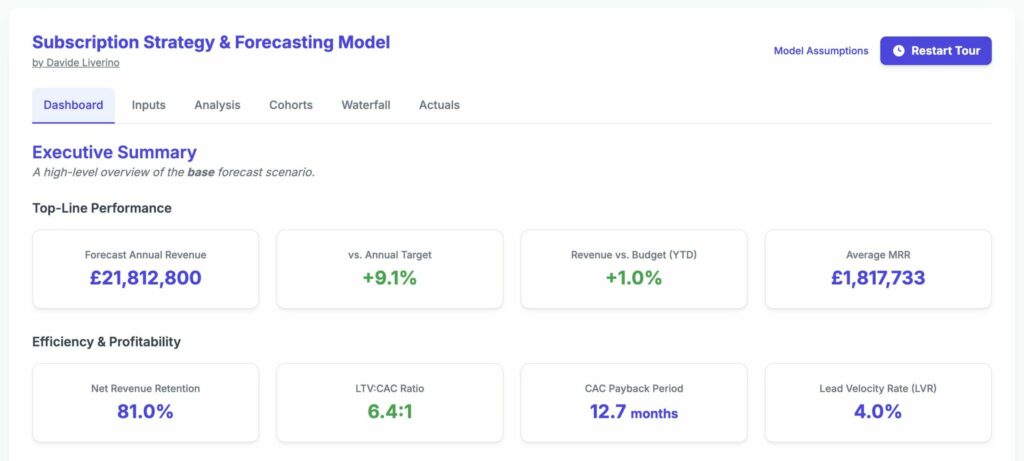

8 PM on a Saturday at Mercato Metropolitano, a large food hall in South London, and we were running out of duck.
Running my first business – a small food start-up – I didn’t have frameworks or KPIs. I just had gut feelings. The sinking feeling of throwing away unsold food at midnight. The quiet satisfaction of seeing a regular customer return for the third week in a row.
I was managing a complex system by pure instinct.
Years later, I was sitting in a weekly trade meeting at a B2B publisher. We, as marketing, presented our MQLs. The editor had a list of the month’s best-performing articles. The sales director had their pipeline on a spreadsheet. Everyone had their own data, and everyone’s numbers were ‘right’. But none of them talked to each other.
We’d leave the meeting without a clear answer to the only question that really mattered: “Are we going to hit our number?”
And I had this strange moment of realisation. It was the exact same problem I had at the food stall, just with more spreadsheets and a bigger P&L. We were managing a complex system by instinct, and hoping for the best.
The real job of a forecast
In publishing, we’ve become obsessed with optimising individual metrics, often vanity metrics. We celebrate a spike in traffic from a viral article or a jump in open rates from a new email template. These are good things, but they are isolated events.
The real engine of a subscription business isn’t a collection of individual metrics. It’s a living system of interconnected levers.
A brilliant piece of journalism (Editorial) drives traffic, which hits a paywall (Product), which converts a reader at a certain CPA (Marketing), who then hopefully sticks around long enough to have a positive LTV (Retention).
Pull one of those levers, and you send a ripple across the entire business. If your forecast doesn’t show you the ripples, it’s not a forecast. It’s a report. And reports only tell you what’s already happened.
This frustration became a bit of an obsession for me. I wanted to build a peace treaty between the spreadsheets. A single place where you could see the ripple effects in real-time. That’s why I built my forecasting model. It wasn’t an academic exercise; it was an attempt to get every team in the same boat, rowing in the same direction.
The four levers your forecast must connect
A truly useful forecast isn’t about predicting the future with perfect accuracy. It’s about understanding how your decisions today will shape your business tomorrow. For a digital publisher, it has to connect these four levers.
1. Acquisition: What does it really cost to get a reader to the front door?
We all track marketing spend. But how does a 10% increase in that spend actually impact the number of trial sign-ups? And how does that, in turn, affect your overall Customer Acquisition Cost (CAC)? If your model can’t connect your ad budget to your CAC, your marketing team is flying blind.
2. Conversion: How much friction is too much?
Your paywall is the heart of your reader revenue. A tiny change in the trial-to-paid conversion rate can have a huge impact on your end-of-year numbers. Your model should let you ask questions like: “What happens to our annual revenue if we introduce a hard paywall that increases conversion by 0.5%, but reduces overall traffic by 10%?”
3. Retention: The leaky bucket.
This is the big one. Churn is the silent killer of subscription businesses. A forecast that treats retention as a static number is useless. You need to be able to see the brutal, compounding effect of a 1% increase in monthly churn over a 12-month period. It’s often the single most important number in the entire model.
4. Lifetime Value: The final score.
LTV isn’t just a metric; it’s the output of everything else you do. It’s a direct result of your acquisition costs, your conversion strategy, and your churn rate. When your model connects all the other levers, you can finally see what truly drives value in your business, and what doesn’t.
From report to simulator
Here’s what I’ve learned: stop treating your forecast as a financial report. Start treating it as an operational simulator.
The goal isn’t to build a perfect, all-knowing spreadsheet. The goal is to build a shared space for conversation. A tool that lets the editor, the product manager, and the marketing director all see how their worlds connect.
When you can sit in a meeting, pull a lever, and watch the entire business model react on a screen in front of you, the conversation changes. You stop defending your own spreadsheet and you start talking about the business.
To see this in practice, I’ve built a completely free, interactive demo model you can explore and use in its current form. For instance, you can see what happens to your end-of-year Released Revenue if you increase Monthly Qualified Leads by 10%, but a lower-quality audience causes your Trial Conversion Rate to dip by 0.5%. You can instantly model how a 1% improvement in Churn for your most valuable subscribers cascades through the system to impact your overall LTV:CAC ratio twelve months from now. Change your Lead Growth Rate to see how it affects your CAC payback period. It’s a foundational tool that shows how these moving parts connect and could easily be expanded to be more encompassing.


You can explore the model here. And if you like to give me your feedback feel free to contact me on LinkedIn.
You don’t need a complex piece of software to start. Build it on a simple Google Sheet. Connect your marketing spend to your trial sign-ups. Connect your conversion rate to your new subscriber numbers. Connect your churn rate to your total subscribers.
The goal isn’t a perfect spreadsheet. It’s a shared understanding. And that’s something you can take to your next board meeting.












